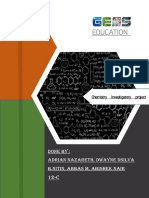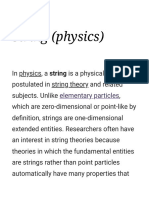Practical File
Uploaded by
Chaitanya DubeyPractical File
Uploaded by
Chaitanya DubeyUniversal Public School
Physics Project File
Topic : “String Theory"
Class – XI
By – Chaitanya Dubey
Universal Public School , Preet Vihar
1|Page
Acknowledgement
I express my sincere thanks to my instructor Ms. Umesh ,who
guided me to the successful completion of this project. I take
this opportunity to express my deep sense of gratitude for their
individual guidance, constant encouragement and immense
motivation which have sustained my efforts at all stages of this
project work.
I extend my sincere thanks to my principal for her support and
for all the facilities provided for the preparation of this project
work.
In the end, I would wish to thank everyone, who motivated me
to continue my work.
Universal Public School , Preet Vihar
2|Page
Certificate
This is to certify that "Chaitanya Dubey" student of
class - 11th 'A' has successfully completed his
Physics project on "String Theory"
under the guidance of “Ms. Umesh’’ ,
Universal Public School , Preet Vihar
3|Page
Contents
Topic Date Signature
What is String Theory
Origin of String Theory
The Concepts of Strings in S.T
Different Versions of S.T
M-Theory
Different Dimensions in S.T
Limitations of S.T
Conclusion
What is String Theory
String theory is a theoretical framework that tries to tackle the problems of
how and why the universe is like what it is now. In string theory, point-like
particles are replaced by one-dimensional entities called strings. String theory
explains how these infinitesimal strings travel and interact with each other. In
normal classical distance scales (larger than the string scale), a string is very
similar to a normal particle with its charge, mass and other characteristics. The
characteristics of strings are directly controlled by their vibrational states.
Universal Public School , Preet Vihar
4|Page
One of the vibrational conditions of the strings matches the states of the
graviton. It is a quantum particle that regulates gravitational force. In this
regard, string theory is also called the theory of quantum gravity.
Origin of String Theory
In general relativity, gravity is a force that bends and warps space-time
around supermassive bodies. Even though gravity is one of the four
fundamental forces in nature, it is very weak compared to the other three
forces (electromagnetism, weak force and strong force). So it can’t be
observed or identified on the scale of subatomic particles.
However, gravity is very dominant in long-distance scenarios. It controls
the structure of the macro universe (galaxies, planets, stars, moons).
Universal Public School , Preet Vihar
5|Page
As far as quantum mechanics is concerned, gravity doesn’t have much
effect. The probable nature of the quantum realm also poses a
significant challenge for the induction of gravity in the quantum realm.
Generally, gravity does not act as a particle as its own. Even if a
hypothetical model is introduced to explain the particle nature of a
gravity particle, it violates fundamental energy laws.
In the 1970s, theorists tried to discard the self-destructive idea of point-
like gravity particles. Instead of point particles, strings were introduced.
Even if strings collide, there will be no infinite energy problem. Strings
can smoothly smash and rebound without implying any physically
nonsense infinities.
The Concept of Strings in
String Theory
String theory was developed from the idea of remodelling point
particles to one-dimensional entities called strings. The
Universal Public School , Preet Vihar
6|Page
interplay of strings can simply be stated by generalising the
theory of perturbation from quantum field theory.
Since string theory has no full non-perturbative explanation,
most hypothetical and theoretical questions are still out of their
domain.
A string can be open or closed. An open string has two open
ends, and a closed string forms a closed loop. Strings have a
tiny dimension, approximately the order of planck length 10^(-
32) m. This is the scale at which quantum gravity is believed to
become significant.
In classical or general relativity scales, strings are not very
different from zero-dimensional point particles. The vibrational
nature of strings determines the characteristics of the particle.
Different types of Strings with ripples
Different Versions of String
Theory
Universal Public School , Preet Vihar
7|Page
Even though bosonic string theory was the first concrete version of string
theory, it was only concerned about bosons (a group of particles that transfer
forces between fermions or matter). In order to negotiate such limits, bosonic
string theory was replaced by a class of theories called superstring theories.
These theories explain both fermions and bosons. So the whole standard model
came under the string theory hypothesis. The most striking development was the
introduction of supersymmetry. It allows each boson to have a counterpart
fermion.
There are many versions of superstring theory.
Type I
Type IIA
Type IIB
Heterotic string theory (SO(32)
Heterotic string theory (E8×E8)
The various versions have different sets of strings. The particles that form at
low energy levels show varied symmetries.
Heterotic, TypeIIB and TypeIIA theory consists of only closed strings.
However, Type I consists of both closed and open strings.
M-Theory
In 1995 Edward Witten stated that all the string theory versions are
just different limiting cases of one super theory.
It is called the M theory. It is based on eleven dimensions. Edward
formulated this conclusion, based on the findings of Michael Duff,
Chris Hull, Ashok Sen and Paul Townsend.
Universal Public School , Preet Vihar
8|Page
Multiple Dimensions in String
Theory
We, as humans, can only perceive and control three dimensions (length, height
and width). With the inception of general relativity, time is considered the
fourth dimension. The only difference is that we can control the first three
spatial dimensions, but we cannot handle the time dimension. In general
relativity, space and time are not separate; space-time is one entity. Gravity is
considered as the by-product of space-time geometry. String theory must
incorporate far more space-time dimensions than standard 3d or 4d space-time
for a solid mathematical base.
Universal Public School , Preet Vihar
9|Page
There are twenty-six and ten dimensions in bosonic string and superstring
theory, respectively. However, M-theory points to space-time with 11-
dimensions.
Limitations Of String Theory
E The major challenge of string theory is that the entire theory does not
have a consistent definition in all scenarios.
Even though string theory is often hailed as the theory of everything, it
still struggles to combine quantum physics and general relativity into a
single universal theory.
Another hurdle string theory puts forth is the prediction of multiple
universes. The landscape of numerous universes has tangled the efforts to
create particle physics theories under string theory.
In quantum mechanics, the principle of observer-dependence is a
fundamental characteristic. String theory is still not able to integrate and
resolve this quantum nature.
String theory has not been able to explain dark energy and dark matter.
They constitute almost 95% of the known universe.
Universal Public School , Preet Vihar
10 | P a g e
String theory cannot state whether the forces and particles forces in
quantum physics can be merged or unified.
String theory does not have a stable explanation of how the constants are
created by nature in the standard model (particle physics).
Conclusion
To conclude String Theory remains to this day a speculative model
which is very difficult to test experimentally as the strings remain
very tiny, However String Theory is one of the only theories to come
this far from it’s original goals and describes the gravitational force
fundamentally in the quantum world therefore if it succeeds it would
be an open door for some of the most mysterious objects observed in
the expanding universe such as ‘Black Holes’ , ‘Super Symmetry , ,
‘Worm Holes’ etc…..
Universal Public School , Preet Vihar
11 | P a g e
Thank You!
Universal Public School , Preet Vihar
12 | P a g e
You might also like
- Biodiesel - Chemistry Investigatory Project100% (2)Biodiesel - Chemistry Investigatory Project11 pages
- Ebola Class 12 Biology Investigatory ProjectNo ratings yetEbola Class 12 Biology Investigatory Project15 pages
- Chemistry INVESTIGATORY PROJECT REPORT ON SALIVARY AMYLASENo ratings yetChemistry INVESTIGATORY PROJECT REPORT ON SALIVARY AMYLASE15 pages
- Physics Project 1 DSFDSGSGDFSG CompressNo ratings yetPhysics Project 1 DSFDSGSGDFSG Compress16 pages
- To Study The Quantity of Casein Present in Different Sample of MilkNo ratings yetTo Study The Quantity of Casein Present in Different Sample of Milk14 pages
- Study of Digestion of Starch by Salivary Amylase and Effecct of PH and Temperature On It.67% (9)Study of Digestion of Starch by Salivary Amylase and Effecct of PH and Temperature On It.5 pages
- Biology Cbse Class 12th Investigatory ProjectNo ratings yetBiology Cbse Class 12th Investigatory Project33 pages
- Bio Project Drug Resistance in BacteriaNo ratings yetBio Project Drug Resistance in Bacteria18 pages
- Physics Investigatory Project On: - : Charging and Discharging of Capacitor in R-C CircuitsNo ratings yetPhysics Investigatory Project On: - : Charging and Discharging of Capacitor in R-C Circuits16 pages
- Chemistry Investigatory Project On Making Plasltic From Strach PDFNo ratings yetChemistry Investigatory Project On Making Plasltic From Strach PDF20 pages
- Physics Investigatory Project: by Tarun Singh of XII B, Manav Rachna International School60% (5)Physics Investigatory Project: by Tarun Singh of XII B, Manav Rachna International School11 pages
- 12 Cbse Physics Project Dehli Public School, Pali: Submitted By: Lakshya UjjwalNo ratings yet12 Cbse Physics Project Dehli Public School, Pali: Submitted By: Lakshya Ujjwal17 pages
- Biology Investigatory Project Class 12 - EditedNo ratings yetBiology Investigatory Project Class 12 - Edited17 pages
- Optical Fibre: Kendriya Viyalaya No.2, Colaba, Mumbai - 05No ratings yetOptical Fibre: Kendriya Viyalaya No.2, Colaba, Mumbai - 0516 pages
- Kendriya Vidyalaya Sector 47 Chandigarh: Physics Investigatory ProjectNo ratings yetKendriya Vidyalaya Sector 47 Chandigarh: Physics Investigatory Project20 pages
- Chocolate Analysis: An Investigatory Project By: Divyam Prabhu Dessai0% (1)Chocolate Analysis: An Investigatory Project By: Divyam Prabhu Dessai19 pages
- Arxiv Sunil Mukhi String Theory Review 1110.2569No ratings yetArxiv Sunil Mukhi String Theory Review 1110.256945 pages
- Introduction To String Theory, by Timo WeigandNo ratings yetIntroduction To String Theory, by Timo Weigand177 pages
- Philosophising Consciousness From String Theory: Ningombam Bupenda Meitei Department of Philosophy, University of DelhiNo ratings yetPhilosophising Consciousness From String Theory: Ningombam Bupenda Meitei Department of Philosophy, University of Delhi9 pages
- Horowitz Singularities in String TheoryNo ratings yetHorowitz Singularities in String Theory46 pages
- Chemistry INVESTIGATORY PROJECT REPORT ON SALIVARY AMYLASEChemistry INVESTIGATORY PROJECT REPORT ON SALIVARY AMYLASE
- To Study The Quantity of Casein Present in Different Sample of MilkTo Study The Quantity of Casein Present in Different Sample of Milk
- Study of Digestion of Starch by Salivary Amylase and Effecct of PH and Temperature On It.Study of Digestion of Starch by Salivary Amylase and Effecct of PH and Temperature On It.
- Physics Investigatory Project On: - : Charging and Discharging of Capacitor in R-C CircuitsPhysics Investigatory Project On: - : Charging and Discharging of Capacitor in R-C Circuits
- Chemistry Investigatory Project On Making Plasltic From Strach PDFChemistry Investigatory Project On Making Plasltic From Strach PDF
- Physics Investigatory Project: by Tarun Singh of XII B, Manav Rachna International SchoolPhysics Investigatory Project: by Tarun Singh of XII B, Manav Rachna International School
- 12 Cbse Physics Project Dehli Public School, Pali: Submitted By: Lakshya Ujjwal12 Cbse Physics Project Dehli Public School, Pali: Submitted By: Lakshya Ujjwal
- Optical Fibre: Kendriya Viyalaya No.2, Colaba, Mumbai - 05Optical Fibre: Kendriya Viyalaya No.2, Colaba, Mumbai - 05
- Kendriya Vidyalaya Sector 47 Chandigarh: Physics Investigatory ProjectKendriya Vidyalaya Sector 47 Chandigarh: Physics Investigatory Project
- Chocolate Analysis: An Investigatory Project By: Divyam Prabhu DessaiChocolate Analysis: An Investigatory Project By: Divyam Prabhu Dessai
- Philosophising Consciousness From String Theory: Ningombam Bupenda Meitei Department of Philosophy, University of DelhiPhilosophising Consciousness From String Theory: Ningombam Bupenda Meitei Department of Philosophy, University of Delhi




































































